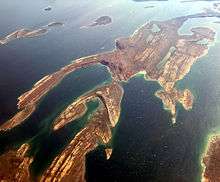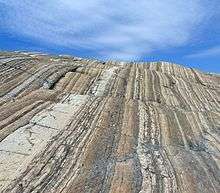Belcher Islands
| Native name: <span class="nickname" ">Sanikiluaq | |
|---|---|
 Belcher Islands, Nunavut (red). | |
| Geography | |
| Location | Hudson Bay |
| Coordinates | 56°20′N 79°30′W / 56.333°N 79.500°WCoordinates: 56°20′N 79°30′W / 56.333°N 79.500°W |
| Archipelago | Belcher Islands Archipelago |
| Total islands | 1,500 |
| Major islands | Flaherty Island, Kugong Island, Tukarak Island, Innetalling Island |
| Area | 2,896 km2 (1,118 sq mi) |
| Country | |
| Territory | Nunavut |
| Region | Qikiqtaaluk |
| Demographics | |
| Population | 812 (as of 2011) |
| Density | 4.0 /km2 (10.4 /sq mi) |
| Ethnic groups | Inuit |
The Belcher Islands (Inuit: Sanikiluaq)[1] are an archipelago in the Qikiqtaaluk Region, Nunavut, Canada. Located in Hudson Bay, the Belcher Islands are spread out over almost 3,000 square kilometres (1,160 sq mi). The hamlet of Sanikiluaq (where the majority of the archipelago's inhabitants live) is on the north coast of Flaherty Island and is the southernmost in Nunavut. Along with Flaherty Island, the other large islands are Kugong Island, Tukarak Island, and Innetalling Island.[2] Other main islands in the 1,500 island archipelago are Moore Island, Wiegand Island, Split Island, Snape Island and Mavor Island, while island groups include the Sleeper Islands, King George Islands, and Bakers Dozen Islands.[3]
History

Before 1914, English-speaking cartographers knew very little about the Belcher Islands, which they showed on maps as specks, much smaller than their true extent. In that year a map showing them, drawn by George Weetaltuk,[4] came into the hands of Robert Flaherty, and cartographers began to represent them more accurately.[5] The islands are named for Royal Navy Admiral Sir Edward Belcher (1799-1877).
Geology


The geologic units of the Belcher Islands are Proterozoic in age. The exposed clastic sedimentary rocks, as well as volcanic and carbonate units record rifting and subsidence of the Superior craton during this period. There are two main volcanic sequences on the Belcher Islands called the Eskimo and overlying Flaherty volcanics. These volcanics form part of the Circum-Superior Belt.
Flora
Other than in valley regions, trees cannot grow on the islands because of a lack of adequate soil.[6]
Fauna
The main wildlife consists of belugas, walrus, caribou, common eiders and snowy owls all which can be seen on the island year round. There is also a wide variety of fish that can be caught such as Arctic char, cod, capelin, lump fish, and sculpin.[7] The historical relationship between the Sanikiluaq community and the eider is the subject of a feature length Canadian documentary film called People of a Feather. The director, cinematographer and biologist Joel Heath spent seven years on the project, writing biological articles on the eider.[8][9]
In 1998 the Belcher Island caribou (Rangifer tarandus groenlandicus) herd numbered 800.[10]
References
- ↑ Issenman, Betty. Sinews of Survival: The living legacy of Inuit clothing. UBC Press, 1997. pp252-254
- ↑ "Section 15, Chart Information" (PDF). pollux.nss.nima.mil. p. 322. Retrieved 2009-08-04.
- ↑ Johnson, Martha (1 June 1998). Lore: Capturing Traditional Environmental Knowledge. DIANE Publishing. pp. 71–. ISBN 978-0-7881-7046-1. Retrieved 17 November 2012.
- ↑ George Weetaltuk (ca. 1862-1956)
- ↑ Harvey, P.D.A. (1980). The History of Topographical Maps. Thames and Hudson. pp. 34–35. ISBN 0-500-24105 8.
- ↑ Belcher Islands
- ↑ Belcher Island Kayak Tour
- ↑ "People of a Feather (2011)". IMDBaccessdate=8 February 2012.
- ↑ "People of a Feather". Retrieved 8 February 2012.
- ↑ Mallory, F.F.; Hillis, T.L. (1998), "Demographic characteristics of circumpolar caribou populations: ecotypes, ecological constraints/releases, and population dynamics", Rangifer (Special Issue 10): 9–60, retrieved 18 December 2013
Further reading
- Bell, Richard T. Report on Soapstone in the Belcher Islands, N.W.T. St. Catharines, Ont: Dept. of Geological Sciences, Brock University, 1973.
- Born, David O. "Eskimo Education and the Trauma of Social Change". Social Science Notes - 1, Northern Science Research Group, Department of Indian Affairs and Northern Development, Ottawa, January 15, 1970
- Caseburg, Deborah Nancy. Religious Practice and Ceremonial Clothing on the Belcher Islands, Northwest Territories. Ottawa: National Library of Canada = Bibliothèque nationale du Canada, 1994. ISBN 0-315-88029-5
- Flaherty, Robert J. The Belcher Islands of Hudson Bay Their Discovery and Exploration. Zug, Switzerland: Inter Documentation Co, 1960s.
- Fleming, Brian, and Miriam McDonald. A Nest Census and the Economic Potential of the Hudson Bay Eider in the South Belcher Islands, N.W.T. Sanikiluaq, N.W.T.: Brian Fleming and Miriam McDonald, Community Economic Planners, 1987.
- Guemple, D. Lee. Kinship Reckoning Among the Belcher Island Eskimo. Chicago: Dept. of Photoduplication, University of Chicago Library, 1966.
- Hydro-Québec, and Environmental Committee of Sanikiluaq. Community Consultation in Sanikiluaq Among the Belcher Island Inuit on the Proposed Great Whale Project. Sanikiluaq, N.W.T.: Environmental Committee, Municipality of Sanikiluaq, 1994.
- Jonkel, Charles J. The Present Status of the Polar Bear in the James Bay and Belcher Islands Area. Ottawa: Canadian Wildlife Service, 1976.
- Manning, T. H. Birds and Mammals of the Belcher, Sleeper, Ottawa and King George Islands, and Northwest Territories. Ottawa: Canadian Wildlife Service, 1976.
- Oakes, Jill E. Utilization of Eider Down by Ungava Inuit on the Belcher Islands. [Ottawa, Ont.]: Canadian Home Economics Journal, 1991.
- Richards, Horace Gardiner. Pleistocene Fossils from the Belcher Islands in Hudson Bay. Annals of the Carnegie Museum, v. 23, article 3. Pittsburgh: Carnegie Museum, 1940.
- Twomey, Arthur C., and Nigel Herrick. Needle to the North, The Story of an Expedition to Ungava and the Belcher Islands. Houghton Mifflin, 1942.
External links
| Wikimedia Commons has media related to Belcher Islands. |
| ||||||||||||||||||||||||||||||||||||||||
|